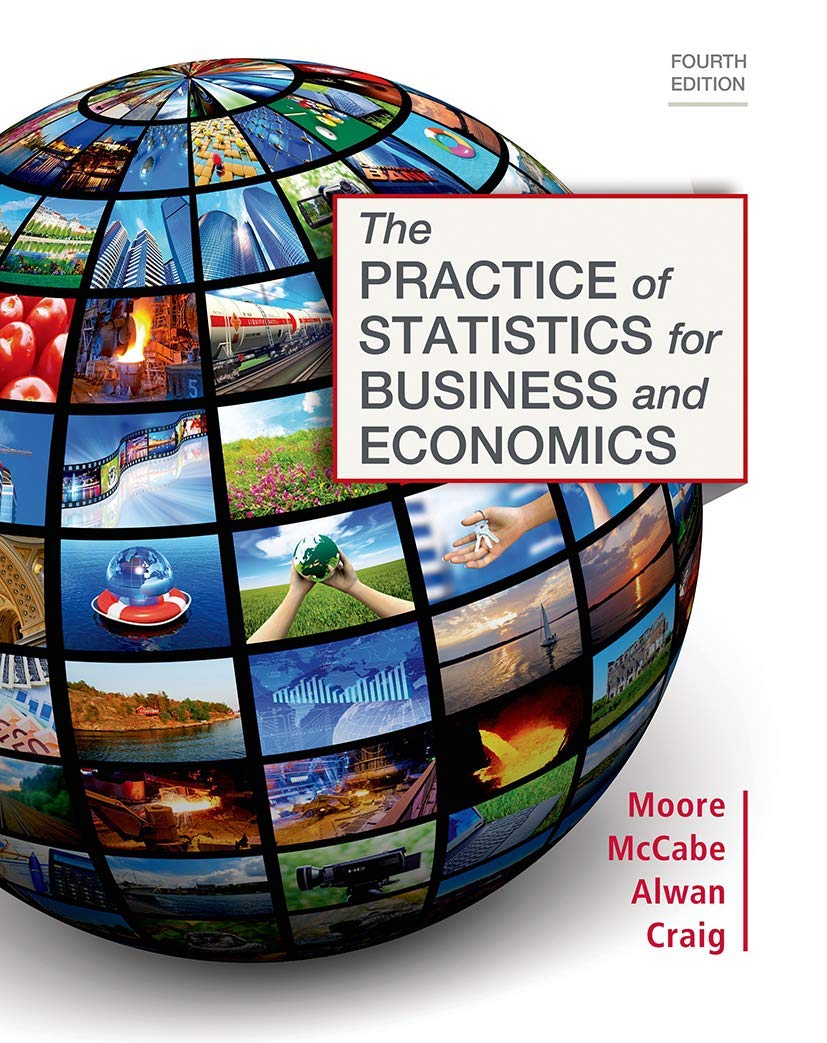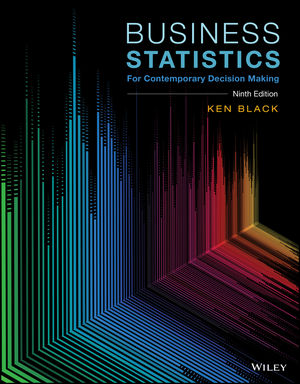Solution Manual for The Practice of Statistics for Business and Economics 4th Edition by Moore
Chapter 1: Examining Distributions Practice of Statistics for Business and Economics
1.1 The value of the coupon is computed by subtracting the DiscPrice from the RegPrice. It is quantitative
because arithmetic operations, like the average value, would make sense.
1.2 The regular price for the Smokey Grill Ribs coupon is 20, the discount price is 11.
1.3 Who: The cases are coupons, there are 7 cases. What: There are 6 variables—ID, Type, Name, Item,
RegPrice, and DiscPrice. Only RegPrice and DiscPrice have units in dollars. Why: The data might be
used to compare coupons to one another to see which are better. We would not want to draw conclusions
about other coupons not listed.
1.4 The cases are apartments. There are 5 variables: Monthly rent-quantitative, Fitness center-categorical,
Pets allowed-categorical, # of Bedrooms-quantitative, Distance to campus-quantitative.
1.5 (a) If you were interested in attending a large college, you would want to know the number of
graduates. (b) If you were interested in making sure you graduate, you would want to know the
graduation rate.
1.6 (a) The cases are summer jobs. (b) Variables might include: position, company, hourly wage, whether
the job is on or off campus, hours per week, other answers are possible. (c) position—categorical,
company-categorical, hourly wage-quantitative, on or off campus-categorical, hours per weekquantitative, other answers are possible. (d) We could use a number as a label. The reason for doing so is
there could be several jobs with the same company or position that you would need to differentiate from
one another. (e) Who: part (a) answer, What: part (b) and (c), Why: To compile a list of available summer
jobs and possibly compare them. We would not want to draw conclusions about other jobs not listed.
1.7 (a) The cases are employees. (b) Employee identification number—label, last name—label, first
name—label, middle initial—label, department—categorical, number of years—quantitative, salary—
quantitative, education—categorical, age—quantitative. (c) Sample data would vary.
1.8 Answers will vary.
1.9 (a) Quantitative. (b) Quantitative. (c) Quantitative. (d) Quantitative. (e) Categorical. (f) Categorical.
For all quantitative variables, numerical summaries would be meaningful; for categorical variables,
numerical summaries are NOT meaningful.
2 Chapter 1 Examining Distributions
1.10 Answers will vary. 1. Rate the customer service of the restaurant—quantitative 2. Is this your first
visit to our restaurant—categorical 3. If not, how many times per month do you visit our restaurant—
quantitative 4. Would you recommend our restaurant to a friend—categorical 5. Do you think our dish
prices are expensive, about right, inexpensive—categorical 6. Rate the taste quality of food you ate
today—quantitative. For all quantitative variables numerical summaries would be meaningful, for
categorical variables, numerical summaries are NOT meaningful.
1.11 Answers will vary. 1. How many hours per week do you study—quantitative, hours 2. How many
nights per week do you study usually—quantitative, nights 3. Do you usually study alone or with
others—categorical 3. Do you feel like you study too much, about right, not enough—categorical.
1.12 Answers and reasons will vary. Examples include: current enrollment, average time to graduate,
graduation rate, job placement percentage, etc.
1.13 (a) The states are the cases. (b) The name of the state is the label variable. (c) Number of students
from the state who attend college—quantitative, number of students who attend college in their home
state—quantitative. (d) Answers will vary. This would tell you which states have large percentages of
students that like to stay “at home” versus small percentages, which indicate students’ preference to leave
home to attend college.
1.14 Each state could be divided as a percentage of the total of the nation’s fatalities to show state
differences; the disadvantage is that states with more population would have a higher number of fatalities.
Instead, each state’s fatalities could be divided by the state population to get a percentage for each state;
this would be a better way to compare state-to-state rates of drunk driving fatalities.
1.15 Answers may vary. The pie chart does a better job because it shows the dominance of Google as a
source, filling almost three-quarters of the pie.
1.16 Answers may vary. It is probably a good idea to round; most of the time we just need an idea of what
the data are telling us.
1.17 The Cost Centers would include, Parts and materials, Manufacturing equipment, Salaries,
Maintenance, and Office lease. We need to include Office lease even though it gives more than 80%,
because otherwise we would only have the top 75% according to the data. So, to get the other 5%, we
need to put Office lease in, giving us 82.12% total.













